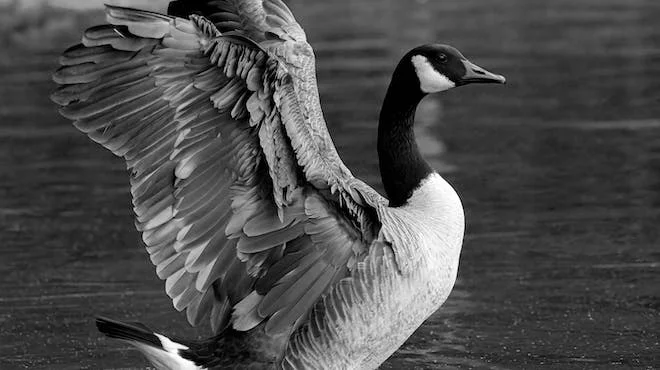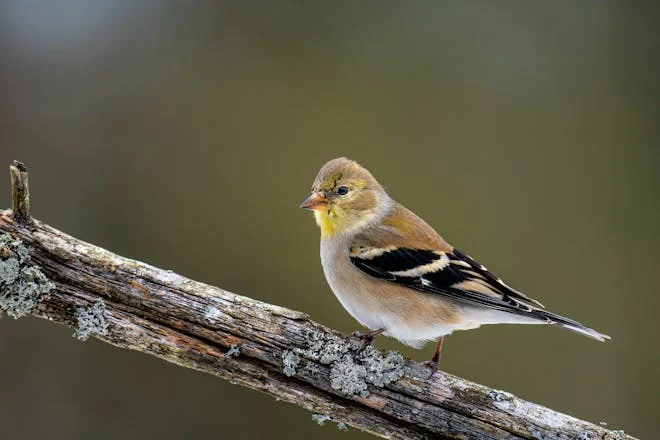
Greetings, and welcome to our blog! Today, we are exploring Mary Oliver’s “Wild Geese.” Join us as we explore the simplicity and depth of her words, unraveling the essence of nature and self.
“Wild Geese” serves as a canvas where simplicity meets profound insight. Oliver’s verses resonate with a universal theme, urging readers to connect with the inherent beauty of life.
Let’s delve into the heart of “Wild Geese,” exploring the subject, the author, the context, the theme, the tone, the poetic techniques used, and the unique structure that elevates this piece of verse.
Wild Geese by Mary Oliver “You do not have to be good. You do not have to walk on your knees for a hundred miles through the desert repenting. You only have to let the soft animal of your body love what it loves. Tell me about despair, yours, and I will tell you mine. Meanwhile the world goes on. Meanwhile the sun and the clear pebbles of the rain are moving across the landscapes, over the prairies and the deep trees, the mountains and the rivers. Meanwhile the wild geese, high in the clean blue air, are heading home again. Whoever you are, no matter how lonely, the world offers itself to your imagination, calls to you like the wild geese, harsh and exciting - over and over announcing your place in the family of things.”
Content
About The Author: Mary Oliver
Mary Oliver (1935-2019) was an esteemed American poet known for her keen observations of nature and the human experience. Born in Maple Heights, Ohio, Oliver developed a deep connection with the natural world during her childhood. Also, Nature was the main theme that later defined her poetic voice. Her verses frequently celebrate the beauty of landscapes, animals, and the transformative power of quiet moments in nature.
Furthermore, Oliver’s literary career gained momentum with the publication of her first collection, “No Voyage and Other Poems,” in 1963. Over the years, she authored numerous collections, including the critically acclaimed “American Primitive”. It earned her the Pulitzer Prize for Poetry in 1984. In addition, she received numerous accolades, including the National Book Award for Poetry in 1992 for her collection “New and Selected Poems.”
Moreover, Mary Oliver’s legacy endures through her timeless poetry, which continues to be celebrated for its simplicity and profound insights. Her works, such as “Wild Geese” and “The Summer Day,” encourage readers to reflect on and appreciate their own lives.
Subject of “Wild Geese” by Mary Oliver
“Wild Geese” by Mary Oliver explores themes of self-acceptance, belonging, and the interconnectedness between human existence and the natural world. Additionally, this poem serves as a gentle yet profound call to embrace one’s life and find solace in its simplicity.
The context of “Wild Geese” by Mary Oliver
Published in Mary Oliver’s collection “Dream Work” in 1986, “Wild Geese” reflects Oliver’s deep affinity for nature and her keen observation of the human experience. As such, Oliver often draws inspiration from the simplicity and beauty found in the natural world.
Featured Elements of “Wild Geese” by Mary Oliver
The poem primarily features wild geese as a metaphorical presence, symbolizing freedom and the innate wisdom of the natural order. The human persona in the poem is implicitly addressed, inviting readers to shed self-judgment.
Persona and Narrative of “Wild Geese” by Mary Oliver
The poem employs a second-person narrative, directly addressing the reader and, by extension, the broader human experience. Therefore, the persona in “Wild Geese” serves as a guide for readers to let go of burdens and discover their place in the world.
Setting of “Wild Geese” by Mary Oliver
The setting of the poem is not explicitly defined, allowing the themes to transcend specific locations. Instead, the poem’s emotional landscape is set against the backdrop of the natural world.
Themes of “Wild Geese” and recurring ideas
Self-Acceptance: The poem encourages readers to accept themselves with compassion, free from the burdens of self-judgment and societal expectations.
Belonging: Themes of belonging and finding one’s place in the world are recurrent. The wild geese serve as a metaphor, emphasizing the idea of being part of a larger, interconnected whole.
Nature and the Human Experience: The poem frequently draws parallels between the natural world and the human experience. Nature becomes a backdrop for introspection and understanding. Throughout the poem, there’s a consistent exploration of the connection between the human experience and the natural world.
Freedom and Liberation: The imagery of wild geese in flight symbolizes freedom and liberation from constraints, inviting readers to shed emotional burdens and embrace the inherent freedom within themselves.
Oliver encourages living in the present moment, free from the weight of the past or the uncertainties of the future. The emphasis on the “now” underscores the importance of appreciating the immediate experiences of life.
Simplicity and Clarity: The poem advocates for simplicity and clarity in life. This suggests that by letting go of unnecessary complexities, individuals can find a clearer path to self-discovery and contentment.
The tone of “Wild Geese” by Mary Oliver
The tone of the poem is gentle, reassuring, and compassionate. Additionally, the poet adopts a conversational tone, speaking directly to the reader. There’s a sense of understanding and empathy, as if the poet is offering guidance and encouragement. However, the overall tone is reflective, encouraging the reader to explore their own emotions and embrace self-acceptance.
The mood of the poem is serene and uplifting. The imagery of nature, particularly the wild geese in flight, creates a peaceful atmosphere as readers engage with the verses. This mood is hopeful, emphasizing the possibility of finding peace within oneself and within the natural order of the world. Overall, there’s a positive and reassuring mood, inviting readers to let go of burdens and connect with the simplicity of life.
Form and Structure of “Wild Geese”
“Wild Geese” consists of 18 lines organized into three unrhymed stanzas. The division into stanzas helps structure the progression of the poem, allowing for a natural flow and emphasizing particular thoughts or ideas.
Line Length and Pauses
The line lengths in the poem vary, contributing to a conversational and accessible style. Some lines are shorter, while others are more extended. The pauses and line breaks serve to create a rhythmic flow, allowing readers to absorb the meaning of each line. The deliberate use of line breaks can be seen as a form of pacing, guiding the reader through the poem.
Punctuation
The poem features a moderate use of punctuation. While there are periods at the end of most lines, some lines lack end punctuation. This contributes to a sense of continuity and fluidity. The sparing use of punctuation aligns with the poem’s conversational and contemplative tone, allowing readers to move seamlessly through the verses.
Rhyme and Rhythm
“Wild Geese” is unrhymed, employing free verse. The absence of a rhyme scheme contributes to the poem’s natural and informal feel. This allows the poet to focus on the power of the language and imagery without a formal rhyme. The lack of rhyme enhances the conversational nature of the poem while making it accessible to a wide range of readers.
The poem is written in free verse and doesn’t adhere to a strict meter or rhyme scheme. However, it still maintains a rhythmic quality through the use of carefully crafted language, line lengths, and pacing.
Line-by-line analysis of “Wild Geese” by Mary Oliver
Line 1: “You do not have to be good.”
The opening lines of “Wild Geese” act as a gentle invitation, welcoming readers into a conversation. The simplicity of the language, devoid of complex words, immediately establishes a connection with the reader. Furthermore, the use of the second person, the direct address to “you,” makes the poem intensely personal. Mary Oliver seems to be extending a comforting hand to each individual reader.
Moreover, this declarative statement, “You do not have to be good,” carries a powerful message of self-acceptance. Through the use of litotes, a form of understatement, Oliver skillfully communicates this liberating idea of “being imperfect”. The deliberate choice to negate the expectation of being “good” creates an immediate sense of relief, as if a weight has been lifted from the shoulders of the reader.
“You do not have to walk on your knees / for a hundred miles through the desert, repenting.”
In these lines, Mary Oliver employs evocative language and metaphor to convey a powerful message about self-atonement. Here, the metaphor of walking on one’s knees for a hundred miles through the desert, repenting, is laden with vivid imagery that immediately captures the reader’s attention. In addition, the choice of walking on one’s knees intensifies the image, suggesting a painful and arduous act of self-punishment.
Oliver skillfully uses this metaphor to underscore the futility of extreme and burdensome efforts toward repentance. Clearly, the desert becomes a symbolic landscape, representing a harsh and unforgiving environment. The exaggerated distance of “a hundred miles” accentuates the impracticality and unnecessary hardship of such a journey.
Through this profound shift in tone, the challenging, harsh, and penitent path toward self-redemption is displayed by the poet. By stating, “You do not have to,” Oliver introduces a liberating idea. Hence, this departure from traditional expectations resonates with readers, inviting them to reconsider their approach to self-forgiveness and acceptance.
Line 4-5: “You only have to let the soft animal of your body / love what it loves.”
In these lines, Mary Oliver introduces personification, presenting the body as a “soft animal.” This imaginative metaphor immediately creates a connection between the reader and their physical being, fostering a sense of intimacy and empathy. The choice of describing the body as a “soft animal” evokes a tactile and tender image, emphasizing the vulnerability and inherent gentleness of our corporeal selves.
By letting “your body love what it loves,” the poet invites the readers to embrace their desires, inclinations, and affections without reservation. Moreover, the term “you only have to” implies how easy and simple it is to achieve self-love and acceptance.

Line 6: “Tell me about your despair, yours, and I will tell you mine.”
In these lines, Mary Oliver extends a compassionate and empathetic invitation, creating a space for shared vulnerability and mutual understanding. The poet opens a dialogue about despair, recognizing it as a universal aspect of the human experience. The simplicity of the language, coupled with the directness of the statement, reinforces the genuine and sincere tone of the poem.
The use of the word “tell” transforms these lines into an invitation for intimate revelation. Oliver beckons the reader to share their personal struggles, acknowledging that everyone carries their own burdens.
In addition, the repetition of the possessive pronoun “yours” emphasizes the individual nature of despair, recognizing that each person’s struggles are unique. By stating, “and I will tell you mine,” Oliver creates a reciprocal dynamic. This exchange becomes a form of emotional intimacy, where the sharing of personal despair becomes a bridge between individuals.
The poet’s willingness to reciprocate, to share her own experiences of despair, further dismantles any sense of hierarchy or judgment. In addition, it suggests that by acknowledging and understanding each other’s despair, a connection can be built.
Lines 7–11: “Meanwhile the world goes on. / Meanwhile the sun and the clear pebbles of the rain / are moving across the landscapes, / over the prairies and the deep trees, / the mountains and the rivers.”
In these lines, Mary Oliver introduces a powerful juxtaposition between personal troubles and the continuous, indifferent progression of the natural world. The use of “meanwhile” emphasizes the simultaneous existence of personal struggles alongside the ongoing movements of nature, highlighting life’s unwavering continuity.
In addition, the vivid and immersive picture of the sun and rain creates a shift from the sad tone of despair into a touch of hope and renewal. This metaphorical language enhances the sensory experience, transforming the elements of nature into dynamic, tactile entities. The choice of “clear pebbles” not only adds a visual dimension but also suggests purity and transparency, evoking a sense of clarity in nature.
The movement of these natural elements invites the reader to move on from the depressing elements of life, just like the flow of nature. The juxtaposition of personal despair with the movements of the natural world serves as a reminder of life’s relentless rhythm. While individuals grapple with their own challenges, the world, indifferent to individual struggles, carries on with its cyclical patterns.
Further, the expansive imagery of landscapes, prairies, deep trees, mountains, and rivers contributes to a broader contemplation of the world’s vastness.
Lines 12–13: “Meanwhile the wild geese, high in the clean blue air, / are heading home again.”
The personal struggles discussed earlier are contrasted here with the imagery of the graceful movement of the wild geese.
The repetition of the word “meanwhile” further solidifies the message of the poet. In addition, the choice of “clean blue air” not only paints a vivid picture of the serene sky but also evokes a sense of purity and clarity. This setting becomes a metaphorical canvas for the journey of the wild geese, emphasizing the freedom of being unrestrained.
The metaphor of the wild geese “heading home again” introduces a powerful symbolic element. More importantly, the idea of home, often associated with a place of safety and belonging, resonates with the theme of finding one’s place in the world.
The flight of the wild geese becomes a poignant allegory for life’s cyclical nature—a journey that involves leaving, exploring, and eventually returning home. This cycle mirrors the human experience of grappling with challenges, seeking understanding, and ultimately finding a sense of acceptance and connection within oneself.
Lines 14–16: “Whoever you are, no matter how lonely, / the world offers itself to your imagination, / calls to you like the wild geese, harsh and exciting —”
In these lines, Mary Oliver amplifies the poem’s inclusive message.
The poet extends her arms to those who may be grappling with loneliness, reassuring them that, regardless of their circumstances, the world remains open and receptive. Furthermore, this acknowledgment of loneliness recognizes the universal human experience of solitude.
The notion that the world “offers itself” implies a gesture that is personified. It infers that the world is not a fixed, predetermined entity but rather a dynamic space that responds to one’s imagination. Further, this can be considered an invitation to explore the possibilities of the world using the lens of imagination.
The continued metaphor of the world calling “like the wild geese” adds an emotional resonance to the poem. The geese, described as both “harsh and exciting,” become symbolic guides, embodying the dualities of existence—the challenging and thrilling aspects of the human experience.

Lines 17-18: “over and over announcing your place / in the family of things.”
In these closing lines of “Wild Geese,” Mary Oliver encapsulates the poem’s central theme and delivers a profound message about the individual’s sense of belonging within the larger context of existence.
The repetition of the phrase “over and over” creates a rhythmic pattern, echoing the idea that the message is persistent and timeless. Moreover, the phrase “announcing your place” implies an active acknowledgment of one’s presence and significance. This phrase conveys the idea that asserting one’s place in the world is not a passive realization but a conscious and affirming declaration of existence.
The concluding phrase, “in the family of things,” carries significant metaphorical weight. By referring to life, or perhaps the entirety of existence, as a “family of things,” Oliver fosters a sense of interconnectedness and unity. This familial imagery suggests that every individual, with their unique experiences and struggles, is an integral part of the larger collective—a familial network that encompasses all living beings and elements of the world.
Conclusion
In conclusion, Mary Oliver’s “Wild Geese” is a poetic masterpiece that transcends its brevity to offer a profound exploration of self-acceptance. Through accessible language and vivid imagery, the poem extends an empathetic invitation to individuals grappling with personal struggles, assuring them of their rightful place in the larger tapestry of existence.
The metaphor of wild geese in flight becomes a poignant symbol of life’s cyclical journey. Oliver’s skillful use of literary devices such as metaphor, personification, and juxtaposition create a captivating emotional cadence that resonates with readers on a universal level.
If you’re curious about Mary Oliver’s poetry, don’t miss her acclaimed work “The Journey” which masterfully captures the transformative power of self-discovery.
RELATED POSTS
View all



